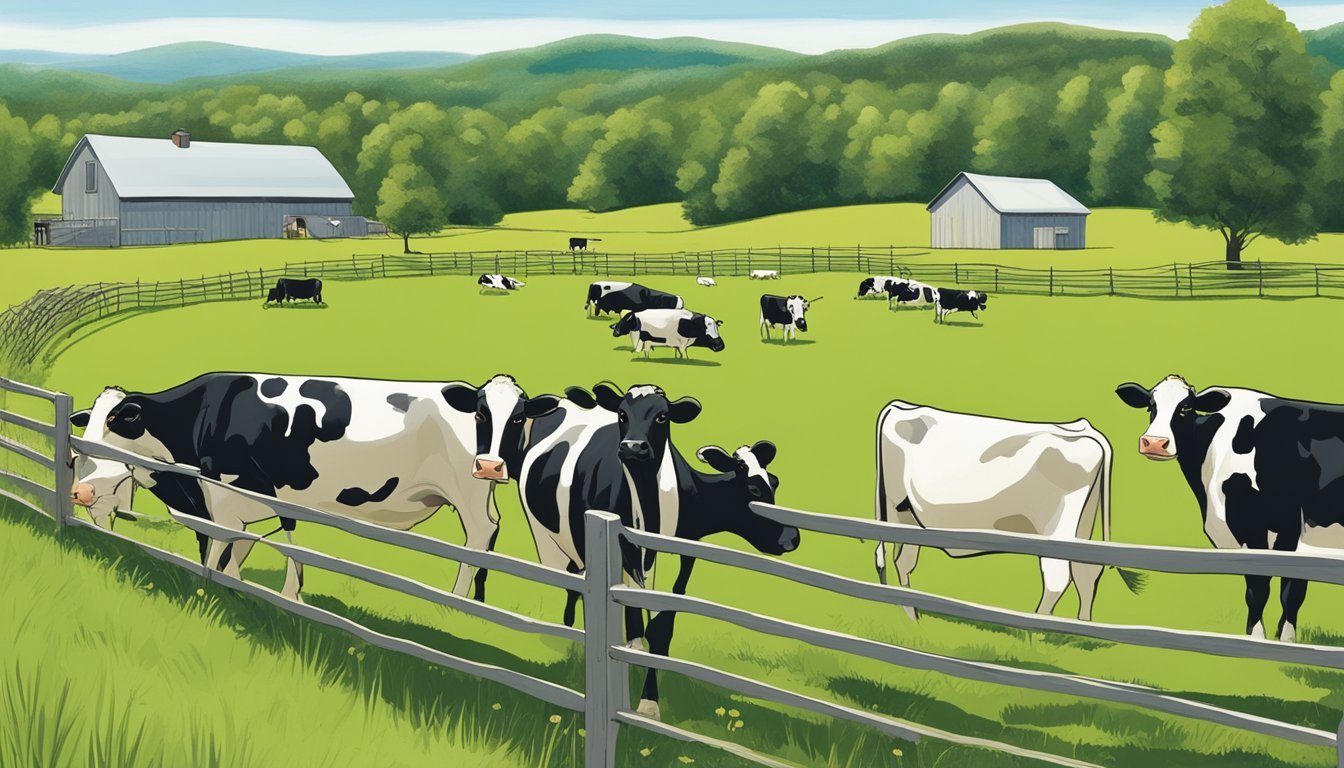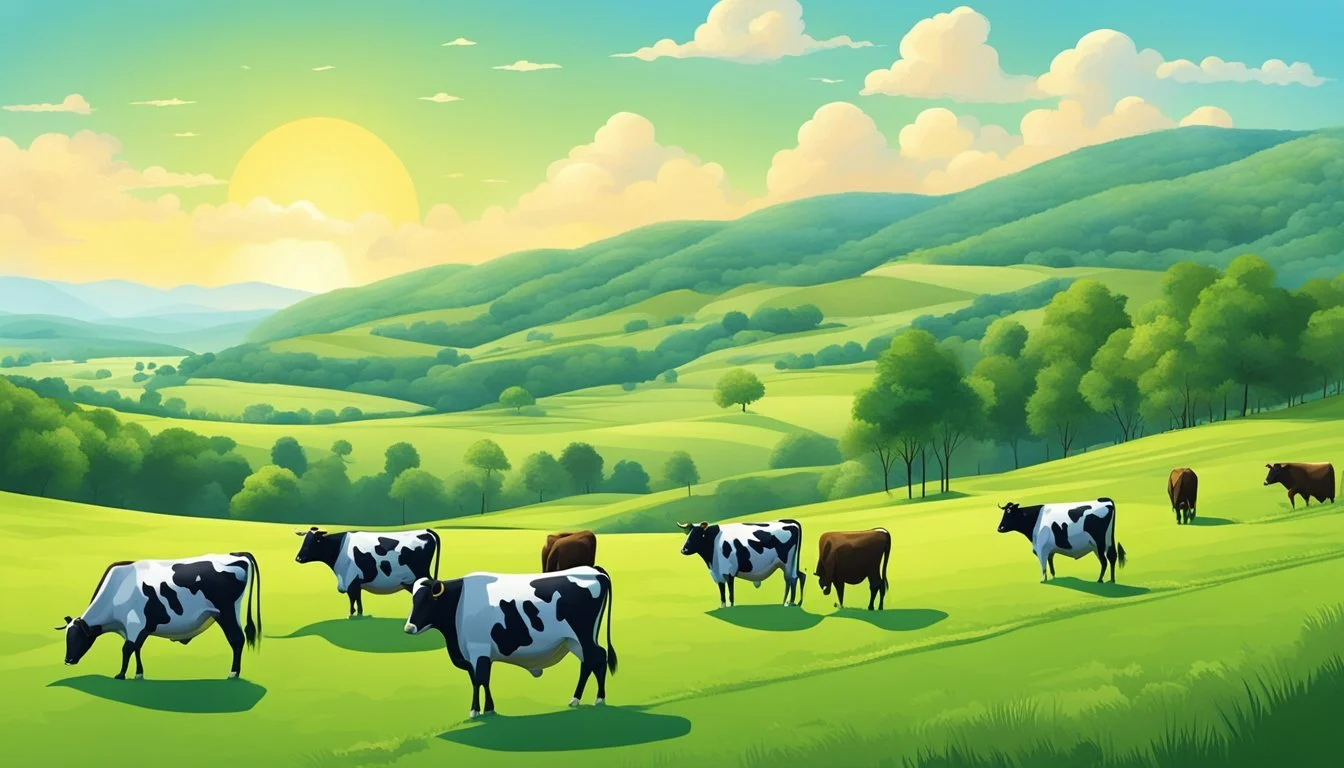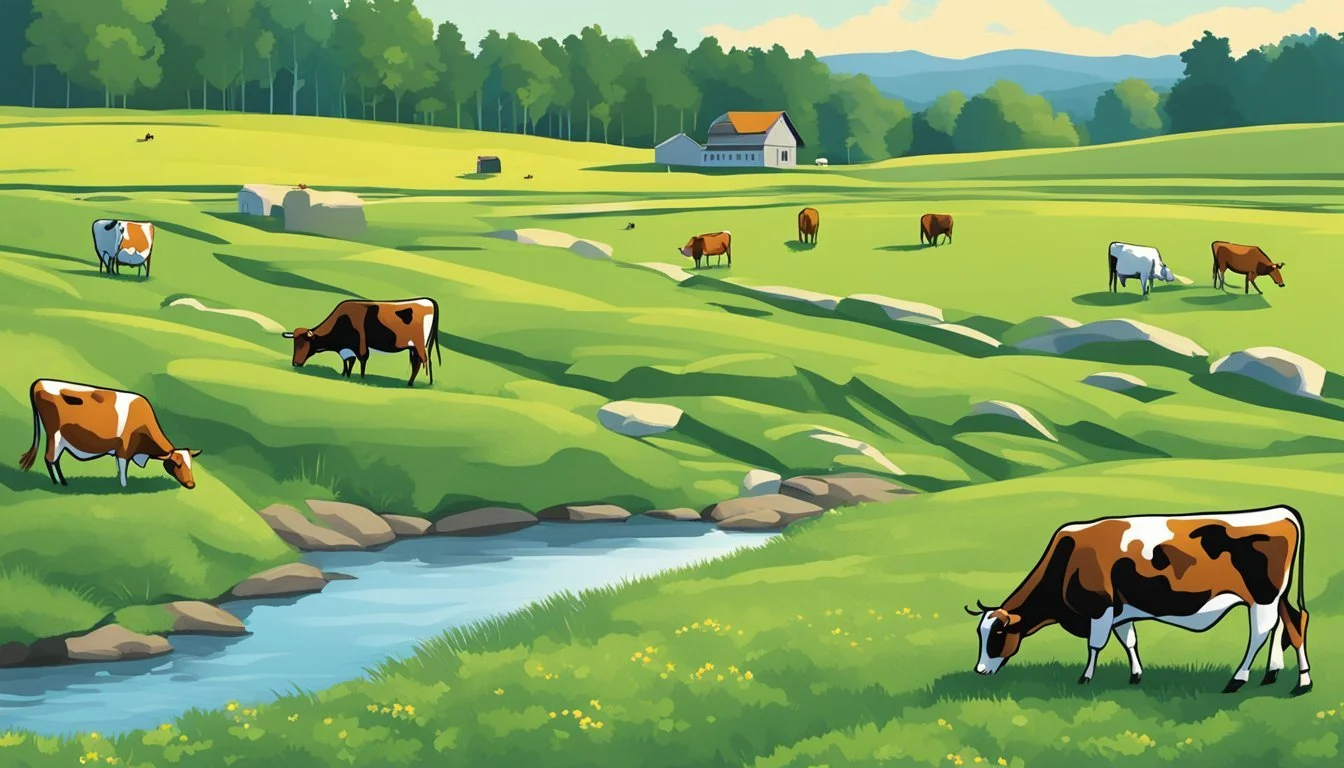Stocking Rate Michigan
Determining Cow Capacity Per Acre on Your Land
Determining the optimal stocking rate for cattle is a critical component of responsible land management in Michigan. The stocking rate is the number of livestock units that can graze a specific area without causing long-term damage to vegetation or soil. This rate is influenced by several factors, including pasture quality, the specific needs of the livestock, and regional climate conditions. In Michigan, with its varying terrain and climate, these factors can significantly impact the number of cows that a property can sustainably support.
Michigan landowners must assess their property's carrying capacity to establish a sustainable stocking rate. The concept involves understanding the delicate balance between the available forage and the nutritional demands of the cattle. It also requires knowledge of the length of the grazing season, which in Michigan can be affected by the state’s distinct seasonal changes. Overstocking can lead to overgrazing and soil compaction, whereas understocking may result in under-utilized resources.
By integrating best practices for managing grazing pressure and considering the state-specific guidelines, farmers can maintain healthy pastures and viable herds. Tailoring the stocking rate to Michigan’s seasonal rhythms and diverse ecosystems ensures the well-being of the cattle and the sustainability of the farm's resources. Calculations and adjustments are essential tools farmers use to accommodate yearly variations and maintain the productivity of their land.
Understanding Stocking Rate
The stocking rate is a critical aspect of managing pasture-based livestock systems, particularly in Michigan, that influences both the health of the land and the productivity of the animals. Proper stocking rates maintain a balance between forage demand and supply throughout the grazing season.
Fundamentals of Stocking Rate
Stocking rate is defined as the number of animal units (AUs) per acre that the land can support without degradation while providing enough forage for the animals. The primary goal is to determine an optimal rate that maximizes productivity while sustaining the pasture's quality. This is particularly pertinent in Michigan, where varying climate conditions affect forage growth and availability.
Determining Animal Units
An animal unit (AU) is a reference standard that equates to 1,000 pounds of live animal weight, typically one mature cow or its equivalent. For example:
1 mature cow (1,000 lbs) = 1 AU
1 bull (1,500 lbs) = 1.5 AUs
Determining the appropriate AUs for a specific property is central to calculating the stocking rate. It's based on the typical weight of the animals grazed and the forage each animal requires.
Stocking Rate Calculations
Stocking rate calculations involve measuring the amount of land against the number of Animal Units (AUs) that it can support over a set period, usually per month (Animal Unit Month, or AUM). In Michigan, one must account for:
Total Land Area: The amount of pasture available for grazing.
Number of AUs: The total weight of livestock divided by 1,000.
Grazing Season: The number of months the pasture will be grazed.
These elements combine to calculate the stocking rate:
Stocking Rate (AUs per acre) = (Total Land Area) ÷ [(Number of AUs) x (Grazing Season)]
The calculated rate guides farmers on how many cows per acre their property can support, which can vary significantly across Michigan due to differences in soil, forage types, and climate.
Land Assessment for Grazing
Determining the appropriate stocking rate in Michigan necessitates a thorough land assessment to ensure that grazing is sustainable and supports the health of both livestock and pasture.
Soil and Forage Analysis
To establish the capacity of land to support cattle, soil and forage quality must be examined. Soil analysis helps determine fertility levels and the presence of essential nutrients like nitrogen, which is crucial for the growth of plants, including common pasture legumes such as clover. Forage analysis provides insights into the nutrient content of the grasses, which directly impacts the amount and quality of feed available for cattle.
Key parameters to assess in soil and forage include:
pH levels
Nitrogen content
Phosphorus and potassium levels
Trace minerals
Organic matter
Pasture Inventory and Condition
One must conduct an inventory of the existing plant species within the pasture to evaluate pasture health and quality. The presence of diverse plant species, including a mix of grasses and legumes, often indicates a higher quality forage and a reduced risk of soil degradation. Assessing pasture condition involves looking for signs of overgrazing, desertification, or compaction, which can negatively affect forage production and yield.
Factors impacting pasture condition:
Plant species diversity
Signs of overuse or erosion
Plant density and coverage
Incidence of weeds
Forage Production and Availability
Understanding forage production involves calculating the potential yield of the pasture. This calculation helps forecast the forage availability across different seasons. Climate, soil type, and pasture size all influence the yield. Forage yield measurements inform the adjustment of stocking rates to align with how much feed is actually available to the cattle. It's vital to match livestock numbers with the pasture's regenerative capacity to prevent overgrazing and maintain consistent forage availability.
Considerations for forage production:
Average annual precipitation and temperature
Pasture size in acres
Expected dry matter yield per acre
Seasonal fluctuations in forage production
By conducting a comprehensive land assessment, one can make informed decisions about the sustainable stocking rate for their property in Michigan.
Grazing Management Strategies
Effective grazing management strategies foster a sustainable balance between the forage demand of cattle and the pasture's ability to regenerate. Michigan farmers can optimize their pasture's productivity by choosing the correct grazing system and managing forage efficiently.
Rotational vs. Continuous Grazing
Rotational Grazing involves dividing pasture land into smaller sections and moving livestock between these sections on a schedule. This method allows forage to recover and regrow, which can prevent overgrazing and soil erosion.
Pros:
Increased grazing efficiency
Enhanced forage production and utilization rate
Reduced risk of overgrazing
Cons:
Higher initial setup costs for fencing and water systems
Requires more intensive management
Continuous Grazing, by contrast, allows livestock unfettered access to a pasture for the entire grazing season. While this approach requires less labor and infrastructure, it can lead to uneven grazing, with some areas overgrazed and others underutilized.
Pros:
Lower initial investment
Less labor-intensive on a day-to-day basis
Cons:
Potentially lower pasture productivity
Greater risk of overgrazing
Managing Forage Demand and Regrowth
Appropriate Management of Forage Demand dictates that the number of grazing days and the stocking density align with the pasture's growth patterns. Balancing livestock numbers with forage availability throughout the season is crucial.
It is essential to monitor Forage Regrowth regularly to adjust grazing pressure and allow sufficient recovery time for plants.
Intensive Grazing Systems
Intensive Grazing Systems, such as Management Intensive Grazing (MIG), require detailed planning and close monitoring but can significantly increase grazing days per acre. They focus on achieving high utilization rates while maintaining pasture health.
Key components include:
Frequent movement of cattle to fresh paddocks
Allowing adequate time for pasture regrowth
Adapting the grazing practice to seasonal growth fluctuations
Implementing effective grazing management strategies maintains pasture health, enhances livestock productivity, and contributes to the overall success of a farm in Michigan.
Regional Considerations for Michigan
In determining the number of cows per acre in Michigan, one must consider the unique regional factors. These include the varying climate and precipitation levels, the diversity of plant species that can be used for forage, and the seasonal variations in forage availability throughout the state.
Climate and Precipitation Impact
Michigan's climate is classified as humid continental, with distinct seasonal temperature changes that influence forage growth and stocking rates. Specifically, annual precipitation ranges from 30 to 40 inches, which plays a crucial role in pasture productivity. Stocking rates in Michigan must adapt to these moisture levels to maintain sustainable grazing practices.
Plant Species Suitable for Michigan
Forage quality in Michigan can be optimized by selecting plant species well-suited to the regional climate. Rye is one such species known for its resilience and compatibility with Michigan's soil and weather conditions. It serves as an excellent choice for grazing purposes, as it can withstand cold temperatures and provide forage in early spring.
Seasonal Variations in Forage
Michigan experiences significant seasonal variations that affect forage availability. In spring and fall, when forage is abundant, stocking rates can be higher. Conversely, during the harsh winters and the hot, dry summers, forage production declines, necessitating a lower stocking density or supplemental feeding to avoid overgrazing and land degradation.
Animal Health and Pasture Welfare
To ensure the vitality of livestock and the land they graze on, careful consideration must be given to soil health, forage availability, and ecological diversity. The balance between these factors is critical for a sustainable grazing strategy in Michigan.
Preventing Soil Compaction and Erosion
Soil compaction reduces the ability of plants to take root and hampers water infiltration, while erosion strips the land of vital nutrients. To prevent these issues:
Rotate grazing areas: This prevents overuse of a specific area, giving soil time to recover.
Control livestock density: Overstocking contributes to compaction. Adhering to an appropriate stocking rate minimizes this risk.
Maintaining Biodiversity and Ecological Balance
Biodiversity underpins ecosystem health, offering resilience against pests and diseases:
Promote native species: They are well-adapted to local conditions and support wildlife.
Manage invasive species: Invasive plants crowd out natives, compromising forage quality and biodiversity.
Forage Quality and Animal Nutrition
High-quality forage is essential for good animal health and reduces reliance on supplemental feed:
Soil testing: Regular testing helps tailor fertilization, supporting optimal forage production.
Plant diverse forages: A variety of plants in pastures provides a balanced diet and can reduce the presence of undesirable plants.
Incorporating these practices into pasture management ensures the health of both the cattle and the land they occupy.
Stocking Options and Customization
To successfully manage livestock in Michigan, ranchers must calibrate their stocking options with precision, accounting for varying cattle types and incorporating potential multi-species strategies to optimize land use and forage consumption.
Custom Grazing Systems
Custom grazing systems offer a flexible solution for ranchers, allowing them to tailor grazing patterns to the specific needs of their property and livestock. These systems can range from set-stocking, continuous grazing, to more dynamic approaches like rotational or management intensive grazing. In Michigan, where the climate and forage growth can be quite variable, a custom option often involves a rotational strategy to ensure pastures have adequate recovery time, leading to sustained forage production and improved soil health.
Stocking Rates for Different Cattle Types
Stocking rates can differ significantly based on cattle type and breed, as different animals have varying rates of forage consumption. A cow/calf pair, for example, typically requires more acreage than a weaned stocker calf due to its greater nutritional needs. Here is an illustrative table of approximate stocking rates in Michigan, accounting for average forage availability:
Cattle Type Stocking Rate (Acre/Cow) Cow/Calf Pair 2 - 2.5 Yearling Steer 1.5 - 2 Dry Cow 1.5 - 2
These rates are estimates and must be adjusted based on actual forage conditions and cattle breeds, especially since some breeds consume more than others.
Multi-Species Stocking Considerations
Incorporating multi-species grazing, such as adding sheep or chickens to a cattle operation, can improve pasture utilization and reduce parasites due to the different grazing behaviors and forage preferences. For example, sheep can graze closer to the ground than cattle and can thus effectively utilize shorter grasses, while chickens can help control insects and fertilize the land. This approach can lead to a more robust grazing management system and better overall land health. However, it requires careful planning to ensure species compatibility and land carrying capacity are maintained.
Calculating Carrying Capacity
Determining the carrying capacity of a property is crucial to balancing forage production with the needs of head of cattle. It ensures the land can sustain the livestock without becoming overgrazed.
Determining Property Carrying Capacity
Property carrying capacity in Michigan depends on various factors, including acreage, forage quality, and regional climate. To calculate, producers must first assess the forage availability in Animal Units (AU) per acre. One AU represents the forage consumption of a 1000-pound cow. For example, an average Michigan property may support an AU equivalent on a monthly production basis. Should the property have 20 acres and the monthly production of forage is 200 Animal Unit Months (AUMs), the carrying capacity would be 10 AUs, or likely 10 cows.
Adjusting Stocking Rates Over Time
Stocking rates should not remain static; they must be responsive to changes in forage production due to weather fluctuations or pasture improvements. Annual assessments may reveal that an acre previously supporting 1 AU could now sustain 1.2 AUs due to increased forage growth. Conversely, a drought could reduce this figure. Thus, the acreage required per head of cattle alters over time, emphasizing the importance of adaptability in grazing plans.
Monitoring Pasture Usage and Animal Performance
Continuous monitoring of pasture usage enables ranchers to maintain optimal forage consumption and animal performance. Physical indicators of overutilization include stunted grass regrowth and soil compaction, which necessitate immediate adjustments. Similarly, close tracking of animal health and weight gain provides insight into whether the land's carrying capacity meets the herd's nutritional needs. Regular body condition scoring of cattle helps indicate if forage intake is sufficient or if stocking rates need reduction.






